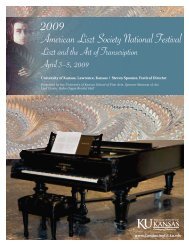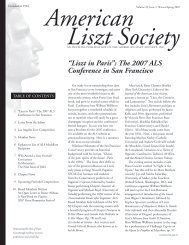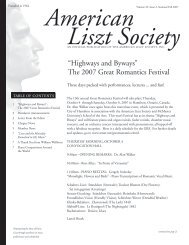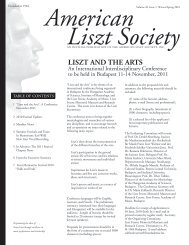Los Angeles International Liszt Competition an Incredible Event
Los Angeles International Liszt Competition an Incredible Event
Los Angeles International Liszt Competition an Incredible Event
You also want an ePaper? Increase the reach of your titles
YUMPU automatically turns print PDFs into web optimized ePapers that Google loves.
A Review of the 2004 <strong>Liszt</strong> Festival<br />
Elyse Mach<br />
(This article is based on Dr. Mach’s<br />
article that appeared in the May<br />
issue of Clavier)<br />
The pi<strong>an</strong>o music of Fr<strong>an</strong>z <strong>Liszt</strong> reigned<br />
high at the 40th Annual Festival of the<br />
Americ<strong>an</strong> <strong>Liszt</strong> Society, hosted by the<br />
School of Music of the University of Illinois<br />
in Urb<strong>an</strong>a. Bona fide lovers of the pi<strong>an</strong>o<br />
works of <strong>Liszt</strong> traveled from as far away as<br />
Fr<strong>an</strong>ce <strong>an</strong>d Taiw<strong>an</strong> to attend <strong>an</strong>d did not<br />
leave disappointed. Most impressive was the<br />
high caliber of playing, with lectures that<br />
were equally comm<strong>an</strong>ding. I<strong>an</strong> Hobson,<br />
the festival’s artistic advisor, <strong>an</strong>d Edward<br />
Rath, the associate director of the School of<br />
Music, should be applauded for their work<br />
to create <strong>an</strong> event of such fine stature.<br />
The festivities beg<strong>an</strong> with a welcome<br />
from Kathleen Conlin, de<strong>an</strong> of the<br />
College of Fine <strong>an</strong>d Applied Arts; Karl<br />
Kramer, director of the School of Music;<br />
Thomas Mastroi<strong>an</strong>ni, president of the<br />
Americ<strong>an</strong> <strong>Liszt</strong> Society; <strong>an</strong>d I<strong>an</strong> Hobson.<br />
Most memorable was Mastroi<strong>an</strong>ni, who<br />
emphasized <strong>Liszt</strong>’s dedication to promoting<br />
the talents of other artists <strong>an</strong>d expressed<br />
the hope that <strong>Liszt</strong> had set <strong>an</strong> example for<br />
teachers today.<br />
William Kinderm<strong>an</strong> gave the first lecture,<br />
“The Diabolical <strong>an</strong>d the Sacred in<br />
<strong>Liszt</strong>: From the Totent<strong>an</strong>z to The Bells of<br />
Strassburg Cathedral,” which addressed the<br />
dichotomy of <strong>Liszt</strong>’s works. He said the<br />
first perform<strong>an</strong>ce of the Totent<strong>an</strong>z (“D<strong>an</strong>ce<br />
of Death”) in 1861, was not by <strong>Liszt</strong>, as<br />
previously believed, but H<strong>an</strong>s von Bülow,<br />
<strong>Liszt</strong>’s student who later became his son-inlaw.<br />
Kinderm<strong>an</strong> showed slides of woodcuts<br />
by H<strong>an</strong>s Holbein, whose images of death<br />
taking on the face of a musici<strong>an</strong> influenced<br />
<strong>Liszt</strong> to write this particular work. The<br />
terrible cholera epidemic of 1832 also<br />
inspired <strong>Liszt</strong>. He became so preoccupied<br />
with death during this time that people<br />
heard him by day <strong>an</strong>d night playing<br />
the “Dies Irae” theme in a multitude of<br />
variations.<br />
Al<strong>an</strong> Walker, honored musicologist <strong>an</strong>d<br />
author of the three-volume definitive<br />
biography of Fr<strong>an</strong>z <strong>Liszt</strong>, presented<br />
the lecture “<strong>Liszt</strong> the Conductor.” It<br />
concentrated on a facet of <strong>Liszt</strong>’s talent<br />
<strong>an</strong>d expertise that remains overshadowed<br />
by his enormous reputation as pi<strong>an</strong>ist <strong>an</strong>d<br />
composer. Walker acknowledged <strong>Liszt</strong> as<br />
the first modern orchestra conductor, who<br />
directed his first concert in J<strong>an</strong>uary 1840 at<br />
the age of 29. His conducting career lasted<br />
only two years, from 1848–50; yet in that<br />
time he introduced sectional rehearsals,<br />
which were nearly unheard of, conducted<br />
with sweeping arcs, <strong>an</strong>d made eye contact<br />
with players. To instigate dynamic ch<strong>an</strong>ges<br />
he rose from a bent position to st<strong>an</strong>ding on<br />
his toes. <strong>Liszt</strong> described sounds by referring<br />
to colors <strong>an</strong>d is said to have once urged <strong>an</strong><br />
ensemble to play more blue. He strove for<br />
the richer coloring in his own works by<br />
selecting special keys: Ab major was his key<br />
of love, E minor the key of hell, E major the<br />
key of prayer, <strong>an</strong>d F# major the key of the<br />
divine. It was also <strong>Liszt</strong> who championed<br />
the direction of modern music, frequently<br />
choosing newer works for his concerts.<br />
The first day included a perform<strong>an</strong>ce by<br />
Thomas Otten for the presentation “<strong>Liszt</strong><br />
the Tr<strong>an</strong>scriber.” It featured exciting<br />
interpretations of the <strong>Liszt</strong> tr<strong>an</strong>scriptions of<br />
“Senta’s Ballad” from The Flying Dutchm<strong>an</strong>,<br />
Isolde’s “Liebestod” from Trist<strong>an</strong> und Isolde,<br />
<strong>an</strong>d “La Camp<strong>an</strong>ella” from Gr<strong>an</strong>des Études<br />
de Pag<strong>an</strong>ini.<br />
The next day Fr<strong>an</strong>k Cooper lectured on<br />
“<strong>Liszt</strong> <strong>an</strong>d the Orchestra,” <strong>an</strong>d All<strong>an</strong> Ho<br />
discussed <strong>Liszt</strong> <strong>an</strong>d Saint-Saëns. A lecturerecital<br />
by Thomas Mastroi<strong>an</strong>ni, “Itali<strong>an</strong><br />
Art <strong>an</strong>d Literature in Années de Pèlerinage,<br />
volume two,” featured eloquent playing <strong>an</strong>d<br />
slides of the poems, paintings, drawings,<br />
14 Americ<strong>an</strong> <strong>Liszt</strong> Society








